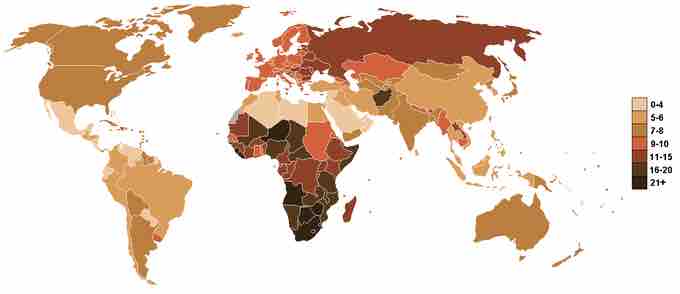Mortality rate is a measure of the number of deaths (in general, or due to a specific cause) in a particular population, scaled to the size of that population, per unit of time. Mortality rate is typically expressed in units of deaths per 1,000 individuals per year; thus, a mortality rate of 9.5 (out of 1,000) in a population of 1,000 would mean 9.5 deaths per year in that entire population, or 0.95% out of the total. This measure is also called the crude death rate. As of July 2009 the crude death rate for the whole world is about 8.37 per 1000 per year according to the current CIA World Factbook.
Just as demographers measure fertility in different ways, they also measure mortality in various ways. Some of the more common demographic measures of mortality include the crude death rate (the annual number of deaths per 1000 people), the infant mortality rate, or the annual number of deaths of children less than 1 year old per thousand live births, and life expectancy, which measures the number of years that an individual at a given age can expect to live, given present mortality rates.
Like fertility, mortality also depends on the age and gender distribution of a population. Older people are more likely to die, so countries with a higher proportion of old people may also have a higher mortality rate. Similarly, men and women may have different life expectancies; therefore, mortality rates can vary with the gender distribution of a population. Thus, for example, the number of deaths per 1000 people can be higher for developed nations than in less-developed countries, despite life expectancy being higher in developed countries due to better standards of health. This happens because developed countries typically have a completely different population age distribution, with a much higher proportion of older people, due to both lower recent birth rates and lower mortality rates.
To more accurately estimate mortality rates, demographers calculate age and gender specific mortality rates. These rates are compiled in a life table, which shows the mortality rate separate for each age group and gender. A life table is necessary to give a good estimate of life expectancy.
Like fertility, mortality rates vary between countries, especially between developing and developed countries. Overall, developing countries tend to have higher mortality rates, higher infant mortality rates, and lower life expectancies. The causes of death also tend to vary between countries. For example, mortality due to malnutrition tends to be much higher in developing countries, whereas in developed countries, people are more likely to die of age-related diseases.
Sociologists have theorized that one of the best predictors of longevity, or a high life expectancy, is education, even when other factors are controlled, people with more education tend to live longer. A few additional years of schooling statistically corresponds to several additional years of life expectancy and vastly improved health in old age. The mechanism through which this works is not the schooling itself, but rather schooling's influence on other health-related behaviors. Education tends to lower the likelihood of smoking and engaging in unhealthy and high risk behaviors. Education also increases the probability of engaging in healthy behaviors, like exercise.

Crude Death Rate by Country
The crude death rate is a measure of how many people per 1000 members of a population die each year. It varies between countries based on various economic, social, and environmental factors.